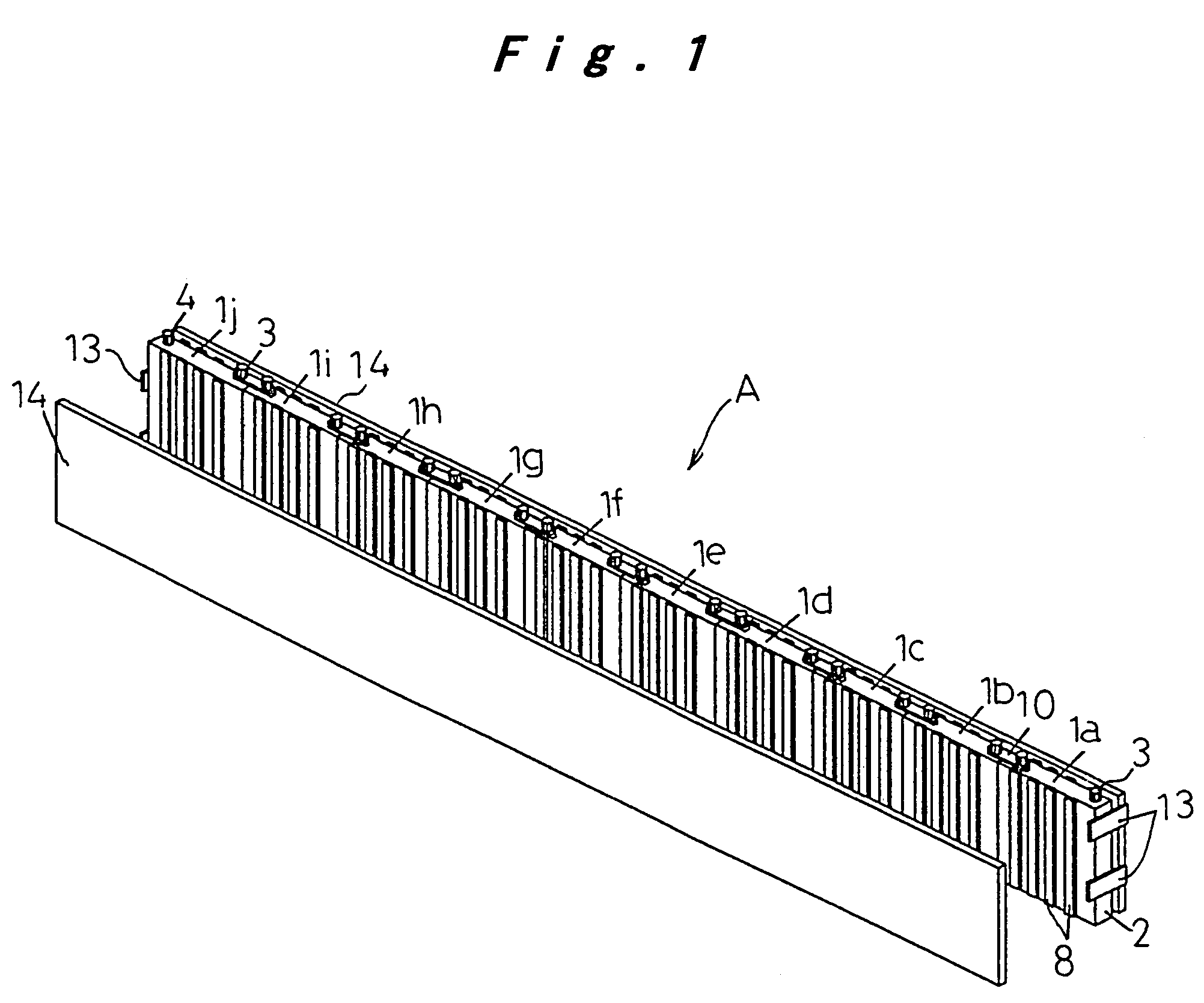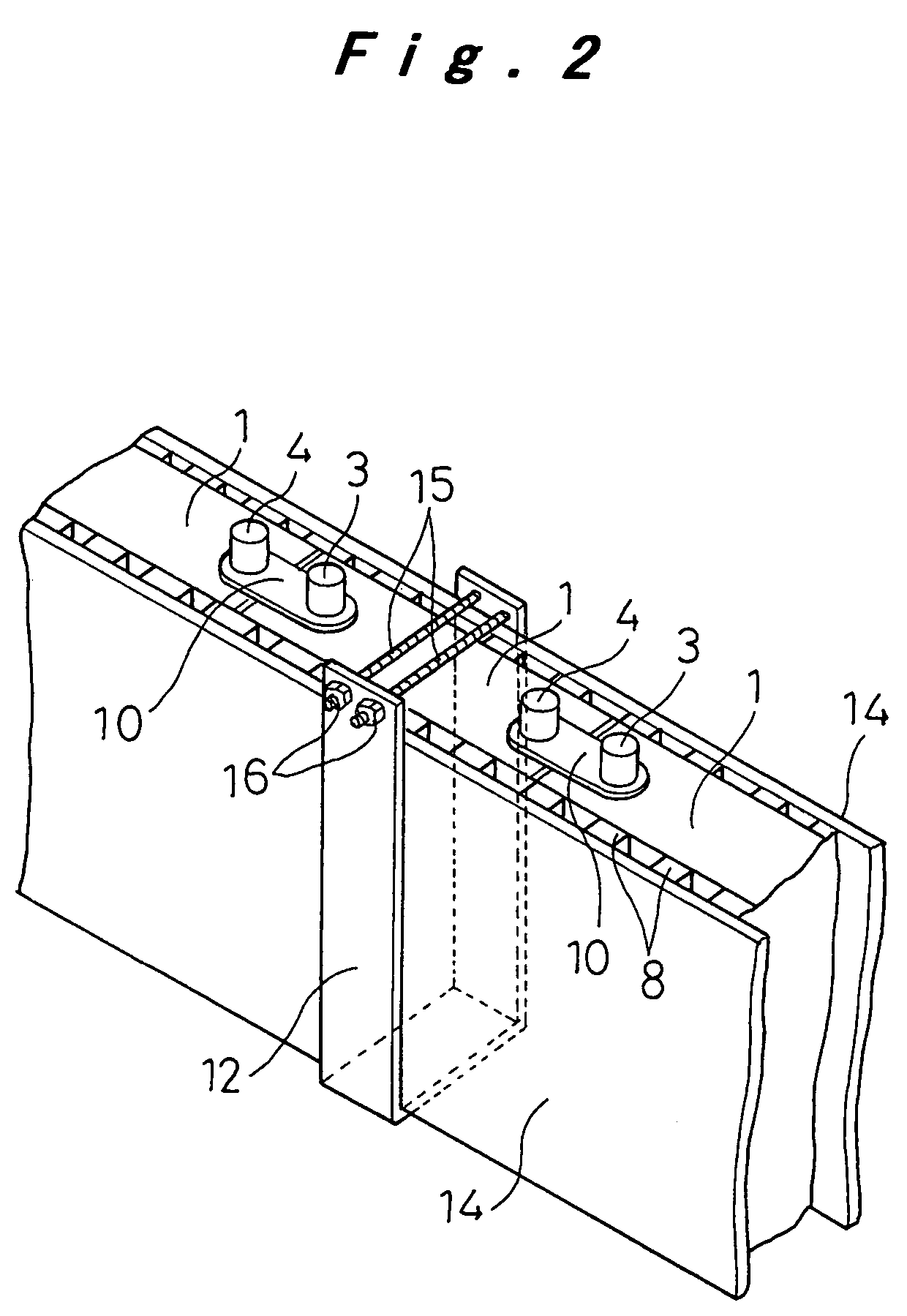Battery pack with thermal distribution configuration
a battery pack and thermal distribution technology, applied in the field of rechargeable batteries, can solve the problems of increasing the number of cells b, increasing the temperature differential between, and increasing the number of cells
- Summary
- Abstract
- Description
- Claims
- Application Information
AI Technical Summary
Benefits of technology
Problems solved by technology
Method used
Image
Examples
first embodiment
[0039]In FIG. 1, the rechargeable battery A pertaining to the first embodiment is structured such that ten cells 1a to 1j that are nickel metal-hybrid rechargeable cells are linked together, and the positive and negative electrode terminals 3 and 4 of the cells 1a to 1j are connected in series to form a battery pack that provides the required output voltage. The cells 1a to 1j are arranged in a chain, with the short (narrow) sides of the battery housings 2 (each of which is formed in a rectangular shape) abutted against one another. These are integrally linked together by being sandwiched between binding plates 14 on the long (wide) sides of the battery housings 2. The two binding plates 14 are fixed by being tightly fitted between binding bands 13 at the ends, as shown in the figure.
[0040]If a large number of cells 1 are to be linked up, tightly fitting the ends of the long binding plates 14 between the binding bands 13 can result in bulging in the middle portion if the binding pla...
fifth embodiment
[0055]FIG. 11 illustrates the structure of a rechargeable battery E pertaining to the Rechargeable battery E is structured such that a battery module 38a, comprising five cells 21a to 21e integrally connected by battery cases 36 provided with partitions 18, and a battery module 38b, comprising five similarly integrally connected cells 21f to 21j are butted together in parallel rows, binding plates 24 are butted against the outsides of the grouped batteries 38a and 38b, and the ends of these binding plates 24 are bound and fixed by binding bands 25.
sixth embodiment
[0056]FIG. 12 illustrates the structure of a rechargeable battery F pertaining to the Rechargeable battery F is structured such that a battery module 38a, comprising five cells 21a to 21e integrally connected by battery cases 36 provided with partitions 18, and a battery module 38b, comprising five similarly integrally connected cells 21f to 21j are butted together in parallel rows with the heat transfer plate 30 sandwiched in between, the ends of this heat transfer plate 30 are linked by the end heat transfer plates 29, the binding plates 24 are butted against the outsides of the grouped batteries 38a and 38b, and the ends of these binding plates 24 are bound and fixed by binding bands 35.
[0057]The heat radiation action and effect of these rechargeable batteries E and F are the same as with the structures described above for the third and fourth embodiments, and therefore will not be described again, but the difference from prior art will be illustrated through the following test ...
PUM
 Login to View More
Login to View More Abstract
Description
Claims
Application Information
 Login to View More
Login to View More - R&D
- Intellectual Property
- Life Sciences
- Materials
- Tech Scout
- Unparalleled Data Quality
- Higher Quality Content
- 60% Fewer Hallucinations
Browse by: Latest US Patents, China's latest patents, Technical Efficacy Thesaurus, Application Domain, Technology Topic, Popular Technical Reports.
© 2025 PatSnap. All rights reserved.Legal|Privacy policy|Modern Slavery Act Transparency Statement|Sitemap|About US| Contact US: help@patsnap.com



